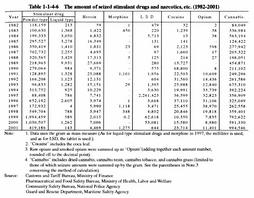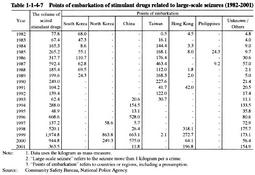| Previous Next Index Image Index Year Selection | |
|
|
2 Crackdown status of drug offenses (1) Seizure of stimulant drugs Table 1-1-4-6 shows the amount of stimulant drugs and other drugs seized in the last 20 years. The seizure amount of these illegal drugs, though being the tip of the iceberg and not coinciding with the actual status, is considered to show trends in the demand for drugs.
The seizure amount of stimulant drugs (powders) stayed somewhere between scores and hundreds of kilograms until 1998, and rose sharply in 1999, reaching around 2,000 kilograms. It then reached around 1,000 kilograms in 2000, and around 420 kilograms in 2001. As for stimulant drugs, the number of cases where seizures of 1 kilogram or more is made, has been decreasing as a whole since 1988, repeating increases and decreases. However, it took an upward turn in 1994 and reached 35 cases in 1999, 25 cases in 2000, and 18 cases in 2001. The average seizure amount per crime among cases with large seizure amounts has exceeded 30 kilograms for 4 consecutive years since 1998, which shows the remarkable increase in such crimes in recent years, and among them, there are some crimes with seizure amounts greater than 100 kilograms. Along with the increase in persons ordinarily received by public prosecutors offices for cannabis crimes, the seizure amount of cannabis also increased and in 1999 registered a record high of around 790 kilograms in the last 20 years. In 2001, it increased further, reaching around 995 kilograms. Table 1-1-4-6 The amount of seized stimulant drugs and narcotics, etc. (1982-2001) (2) Point of embarkation of stimulant drugs Table 1-1-4-7 shows the points of embarkation of stimulant drugs related to large-scale seizures in the last 20 years. Korea and Taiwan were major points of embarkation of stimulant drugs related to large-scale seizures before and after 1984, the second boom period of the abuse of stimulant drugs, and then China and North Korea have been recognized as the major points of embarkation respectively since 1993 and 1997.
Table 1-1-4-7 Points of embarkation of stimulant drugs related to large-scale seizures (1982-2001) (3) Implementation status of the Narcotics Provision Law The Law Concerning Special Provisions for the law to Control Narcotics and Psychotropic Substances, etc. and Other Matters for the Prevention of Activities Encouraging Illicit Conducts and Other Activities Involving Controlled Substances Through International Cooperation (hereinafter referred to as the Narcotics Provision Law) was enacted on October 5, 1991 and came into force in July 1992. Under the Narcotics Provision Law, the regulations concerning punishment for illegal smuggling operations as businesses, punishment for money laundering , and confiscation and collection of the corresponding value to be confiscated necessary for drug crime proceeds, and the realization of controlled delivery on an international level, were newly established.
Table 1-1-4-8 shows the number of Narcotics Provision Law violations since 1992. Though numbering fewer than 10 from 1992 to 1995, the number of Narcotics Provision Law violations has stayed over the 20-case level after jumping to 25 in 1996. The number was 21 in 2001. Table 1-1-4-9 shows the application status of regulations of confiscation and of collection of the corresponding value to be confiscated , which are one of the characteristics of Narcotics Provision Law violations. The total amount of confiscation and collection of the corresponding value to be confiscated, which exceeded ¥100 million in 1997, reached around ¥670 million in 1998, around ¥1,900 million in 1999, around ¥540 million in 2000, and ¥3,787 million in 2001. According to these figures, it can be pointed out that these regulations of which purpose is not to make smuggling groups acquire crime proceeds from drugs, are becoming effective. Table 1-1-4-8 Trends in the number of cases of Narcotics Provision Law violations (1992-2001) Table 1-1-4-9 Application status of regulations of confiscation and collection of the corresponding value to be confiscated concerning Narcotics Provision Law violations (1992-2001) |



